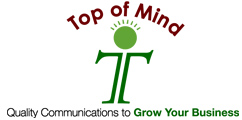AFFINITY MARKETING … AND ITS COUSIN, ALLIANCE MARKETING
In This Era of Social Distancing & Self-Quarantining

Back in March, most of us thought this pandemic would be short-lived and we’d all be back to normal … including the way we create relationships via marketing. Now, the new normal is not knowing when coronavirus will be a thing of the past.
So, of necessity, marketers must turn to alternative ways to leverage their promotional efforts. Two powerful ways to do that are Affinity Marketing and a similar approach through Alliance Marketing. As a place to start, consider the magic of leverage.
Leveraging the Math – Make 1 + 1 = 3 or 4 or More
It’s no secret … people buy from people they know and trust. Typically getting to know someone, particularly a vendor, is a long process of meeting, building rapport and becoming comfortable with the relationship. Likewise, trust is developed based on a “gut feel” at the front-end … then reinforced or revised over an extended period of time.
Since we are all anxious to do business as quickly as possible, compressing the time frames of knowing and trusting is a worthwhile endeavor with a tangible payoff. Affinity and Alliance Marketing delivers on that compression.
In this article we’ll take a look at both plus compare and contrast similarities as well as unique features of each. Additionally, we’ll provide some guidance on approaching and securing the endorsement of affinity groups.
Affinity Marketing
Affinity marketing takes place when a homogeneous group, with similar purchasing needs and buyer profiles teams up with a vendor to provide goods or services to the group constituency. Examples include associations and other membership organizations, service groups, non-profits and charities.
The appeal to the group centers around three key elements of the affinity relationship:
- Providing a value-add to the group members by harnessing the mass purchasing power of the group to exact price concessions, product exclusivity and often private labeling
- The group provides members added motivation to stay in the organization.
- More frequently than not there is revenue sharing between the vendor and the group.
Vendors that successfully pursue affinity marketing, measurably increase their acceptance by the target buying audience. By implication, endorsement by the group indicates that due diligence has been performed and the vendor comes well recommended as being trustworthy, professionally competent and offering special benefits to the membership. That means the vendor is more quickly known and trusted by a mass audience.
Additionally, buyers in the target audience are similar in their purchasing needs and habits so market research, product design and sales channels are more easily identified and implemented.
There are literally hundreds of affinity groups for committed vendors to introduce themselves to. The place to start is to identify potential affinity groups that will benefit from your offerings. Your checklist to determine the profile of a potential relationship and the terms to present are the three key elements listed above.
The next step, as in any sales solicitation, is to mount a campaign to contact key decision-makers to present why the organization should consider partnering with you for the benefit of the membership … as well as member retention and revenue potential for the group.
Depending on the size of the organization, your likely candidates to contact are the CEO/ Executive Director in smaller associations and Director of Marketing (or similar title) in larger groups.
Two words of caution:
- Be rigorous in your research of the group to determine the likely positive reception for your offerings by the membership.
- Convince yourself that the group’s leadership is well respected by members and that members perceive true value from their participation in the organization.
Your time and success will be severely compromised if either of the above proves to be negative.
Two quick examples of success …albeit probably of a greater magnitude than you may pursue … but instructive nonetheless.
JP Morgan Chase was the first bank to come up with the idea of marketing credit cards by leveraging the strength and recognition of a third-party group. In doing so the bank targeted colleges/universities, professional groups and cause-related non-profits/charities. Needless to say, this proved to be a major home run for JP Morgan Chase and soon copy-cat marketing by other financial institutions became a widespread model.
AARP serves seniors age 50 and older. Benefits of membership include a myriad of affinity partners offering access to healthcare products, auto and homeowners’ insurance, Medicare supplement plans and much more.
Alliance Marketing
Alliance Marketing is similar to Affinity Marketing in that existing customer relationships are leveraged. Alliance marketing relationships are typically forged between two non-competing businesses, both of which have offerings that will benefit the prospects, customers and referral resources of the other.
At a retail level such alliances might include a bridal shop teaming up with a local florist to prominently promote each other’s products and services.
In the world of IT, promotion of a new software application or technology device may piggy-back on the existing reputations and client relationships of a partner company. The company with the existing relationships wins by demonstrating thought leadership in introducing a unique innovation.
Two wholesale distributors may team up to leverage an existing distribution network. A notable example is Starbucks’ alliance with Pepsi to distribute its ready-to-drink beverages, none of which competed with Pepsi’s offerings. The win-win: Starbucks enjoys mass distribution without the time and dollar investment to develop their own. Pepsi expands its product deliverables and enhances its revenue from the partnership.
Caution in choosing an alliance partner is critical. In addition to ensuring that you and a prospective partner are not competitors, your selection criteria must include a thorough vetting of the reputation, customer base and level of commitment to the joint enterprise. An enormous amount of time and money can be poured down the drain by not doing extensive homework at the outset.
Here are a few other alliances that may be mutually beneficial. You’ll come up with others that will complement your own offerings.
- Employee benefits consultant/commercial property & casualty insurer
- Website developers/website content writers
- Human resource consultants/CPAs
- Property managers/commercial real estate brokers & leasing agents
In Conclusion
We started this discussion with the promise of Leveraging the Math – Make 1 + 1 = 3 or 4 or More. Both Affinity Marketing and Alliance Marketing are vehicles to make that happen. Take some time and think through how one or both can turbo-charge your marketing success.
